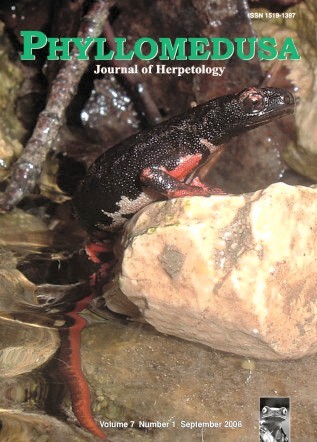Relationship between morphotypes of Atelognathus patagonicus (Anura, Neobatrachia) and environmental conditions: evidence and possible explanation
DOI:
https://doi.org/10.11606/issn.2316-9079.v7i1p35-44Keywords:
Anura, Neobatrachia, Atelognathus patagonicus, morphotypes, phenotypic plasticity, reversible changes, Patagonia, ArgentinaAbstract
The frog Atelognathus patagonicus (Gallardo, 1962) is endemic to an endorheic pond system in basaltic basins, in Laguna Blanca National Park and its surroundings, in northwest Argentinean Patagonia. The species has two morphotypes, aquatic and littoral, which were studied in Laguna Batea, a semi permanent pond. Aquatic and terrestrial samples were taken over a period of 31 months, including periods of drought and periods of normal precipitation. Evidence was found of the reversible character of the two morphotypes. The changes in the phenotype were consistent with the water level and limnological conditions in the pond. We believe that the change and subsequent reversal of the somatic features in these frogs are an opportunistic alternative showing remarkable plasticity of the species, which can thus inhabit both permanent and temporary ponds. Therefore, the two morphotypes, aquatic and littoral, cannot be considered as "fixed forms" within a given population, as other authors have speculated, and do not correspond to ontogenetic states.Downloads
Download data is not yet available.
Downloads
Published
2008-06-01
Issue
Section
Articles
License
All material originally published in Phyllomedusa belongs to Escola Superior de Agricultura Luiz de Queiroz - Universidade de São Paulo. All contents are under a license of Creative Commons BY-NC-ND.How to Cite
Cuello, M. E., Úbeda, C. A., & Bello, M. T. (2008). Relationship between morphotypes of Atelognathus patagonicus (Anura, Neobatrachia) and environmental conditions: evidence and possible explanation. Phyllomedusa: Journal of Herpetology, 7(1), 35-44. https://doi.org/10.11606/issn.2316-9079.v7i1p35-44



 Impact Factor (JCR): 0.600
Impact Factor (JCR): 0.600 CiteScore: 1.0
CiteScore: 1.0